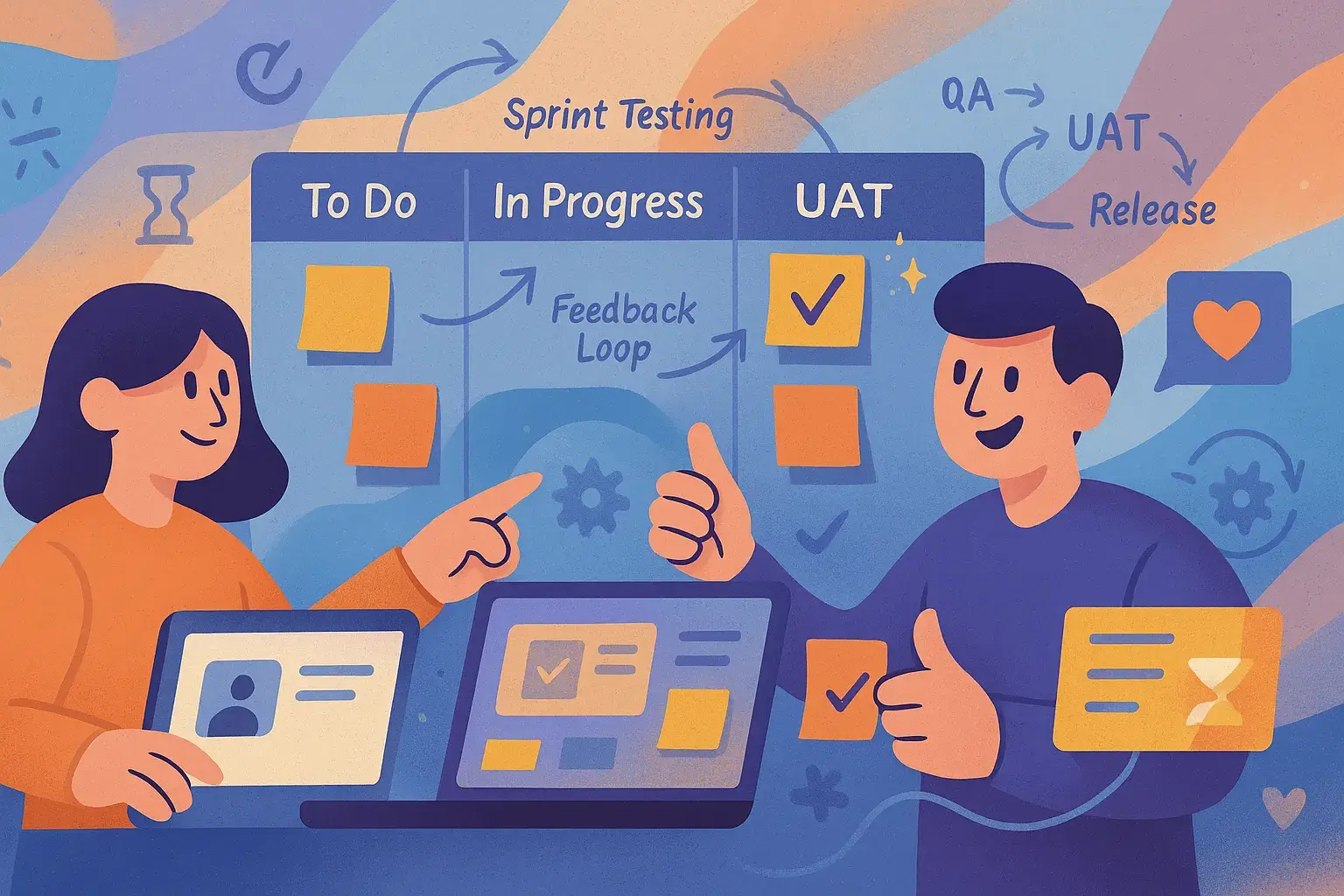Key Takeaways
- User Acceptance Testing in Agile happens iteratively throughout development cycles rather than as a single phase at the end of the project.
- Effective Agile User Acceptance Testing requires planning early, involving actual end-users, and maintaining clear acceptance criteria linked to user stories.
- Time constraints and user availability are major challenges in Agile UAT, requiring incremental testing and building dedicated user groups.
- Primary UAT participants should be end users and business stakeholders who understand real-world business needs, not just QA specialists.
- UAT documentation in Agile should be lightweight but specific, focusing on user-centric test scenarios rather than technical specifications.
While traditional approaches delay user feedback until the end, Agile UAT catches issues early when they cost less to fix and keeps development aligned with what users actually need. Learn how to implement this user-centered approach in your sprints 👇
What is UAT in Agile?
User Acceptance Testing in Agile validates that completed features actually work for real users. Unlike traditional development, where UAT happens once at the very end, Agile teams run UAT iteratively throughout their development cycles. Users test completed features after each sprint, providing feedback while developers can still act on it.
The core purpose remains the same: confirming software meets business requirements from the user’s perspective. But the timing and approach are completely different.
Key characteristics of Agile UAT include:
- Iterative testing: Users test completed features after each sprint rather than waiting for the entire product
- Early feedback loops: Developers get user insights while adjustments are still feasible
- Stakeholder involvement: Business representatives and end-users participate throughout development, not just at the end
- Focus on user stories: Testing validates that user stories are implemented correctly and make sense to actual users
For example, if your team is developing an e-commerce platform, UAT might involve real customers attempting to complete purchases, add items to wishlists, or navigate product categories after each sprint. Their feedback focuses on whether features make sense from a user’s perspective, not just whether they work technically.
Steps to Conduct UAT testing in Agile
Running UAT within Agile sprints sounds challenging, but it’s manageable with the right approach. The key is building UAT activities directly into your sprint planning rather than treating them as an afterthought. Here’s a structured process that fits within sprint timelines without slowing down development.
1. Analyse Business Requirements
Start by thoroughly reviewing user stories, acceptance criteria, and business requirements with your product owner. Identify which functionality needs user validation and clarify any ambiguous requirements before testing begins. Map these requirements to specific features so your testing stays focused on what actually matters to users.
2. Create a UAT Plan
Develop a concise plan that outlines testing scope, timeline, and resources within your sprint constraints. Define clear entry and exit criteria for the UAT phase and establish communication channels between testers, developers, and stakeholders. Schedule testing early enough in the sprint to allow time for fixes, and identify which environments will be used for testing.
3. Identify Test Scenarios and Cases
Draft user-centric test scenarios based on how people actually use your software in the real world. Focus on business processes rather than technical specifications, covering both happy path scenarios and edge cases. Keep test cases simple enough for non-technical users to execute while ensuring they validate all acceptance criteria from your user stories.
4. Select the Testing Team
Include actual end-users whenever possible, not just QA professionals. Involve business stakeholders who understand the requirements and consider mixing experienced users with newcomers to get diverse perspectives. Ensure testers receive appropriate training on both the application and testing procedures, and assign a UAT coordinator to manage the process and track results.
5. Run Tests and Record Results
Execute tests in an environment that closely mimics production conditions. Document all results, including successes and failures, capturing detailed information about defects with steps to reproduce and screenshots. Prioritise issues based on business impact and maintain a defect tracking system that developers can easily access and understand.
6. Obtain Sign-off from Stakeholders
Present test results and findings to key stakeholders, addressing any outstanding concerns or questions. Document formal acceptance of the tested features and include any conditions for acceptance if certain issues must be resolved. Ensure sign-off is properly documented and stored for future reference and audit purposes.
While implementing UAT in Agile presents unique challenges (the ones we will discuss), having the right test management tools can make all the difference.
aqua cloud was designed specifically to support the iterative nature of Agile UAT processes with seamless sprint integration. Unlike traditional testing platforms, aqua’s AI Copilot can transform your requirements into comprehensive test cases in seconds, saving your team up to 97% of the time typically spent on test case creation. With aqua’s bi-directional Jira integration, you maintain perfect traceability between user stories, acceptance criteria, and test cases, allowing your team to quickly adapt when requirements change mid-sprint. Confluence and Azure DevOps integrations are cherry on top, while native Capture integration cuts bug recording process significantly down, improving QA-dev communication massively. By bringing all UAT activities into one collaborative workspace, aqua helps your Agile team overcome the time constraints and documentation gaps that often plague UAT processes.
Transform your Agile UAT from a bottleneck to a competitive advantage with aqua cloud
UAT Best Practices for Agile Teams
Getting UAT right in Agile requires more than just following a process. These practices help teams integrate user validation seamlessly into their sprints while maintaining development velocity.
Plan UAT Early
Start UAT planning at sprint kick-off, not when development finishes. Identify UAT participants before coding begins and reserve dedicated time slots in your sprint timeline for testing activities. Create test cases alongside development work and ensure testing environments are prepared and accessible when needed.
Understand Your Users
Know who actually uses your product and involve them directly in testing. Recruit representative end-users when possible and create detailed personas to guide testing scenarios. Consider different skill levels and accessibility needs, and observe users during testing to capture pain points they might not verbalise.
UAT is where you discover the huge gulf between what the user asked for (and signed off on the specification of), versus what they actually wanted.
Write Specific and Detailed Test Cases
Quality test cases produce quality feedback. Use clear, non-technical language that business users can understand and include specific steps with expected results. Link each test case to user stories and acceptance criteria, provide context about why features matter to users, and use consistent templates that capture all necessary information.
Define Clear Acceptance Criteria
Establish unambiguous standards for what constitutes success. Write acceptance criteria using “Given-When-Then” format and make them measurable whenever possible, like “Page loads in under 2 seconds.” Review criteria with stakeholders before testing begins and avoid vague terms like “user-friendly” without defining what that actually means.
Maintain a Collaborative Approach
Break down silos between development, QA, and business teams. Hold joint UAT planning sessions with all stakeholders and create shared dashboards for tracking progress. Establish quick feedback loops when issues surface and conduct UAT demos where developers can observe users testing their features directly.
Automate Where Appropriate
Balance manual exploration with automated validation. Automate repetitive UAT scenarios so human testers can focus on complex edge cases and user experience issues. Create reusable test data sets for consistent testing and use recording tools to document sessions for developer reference. Consider exploratory testing to complement your scripted test cases.
Now it’s time to look at the challenges that will arise once you integrate UAT into your Agile workflows.
Common UAT Challenges in Agile (And How to Fix Them)
UAT in Agile environment sounds great in theory, but real teams hit predictable roadblocks. Here are the challenges that trip up most teams and practical ways to handle them.
Time Constraints
Short sprints don’t leave much room for thorough user testing, especially when development runs late.
How to handle it: Test incrementally throughout the sprint instead of cramming everything into the final days. Focus on critical functionality first and consider dedicating a “hardening sprint” before major releases for comprehensive validation. Use time-boxed testing sessions that target specific features rather than trying to test everything at once.
User Availability
Real users have day jobs that don’t revolve around your testing schedule. Getting them to participate consistently is tough.
How to handle it: Build a dedicated group of users who understand they’ll be called on regularly for testing. Schedule sessions well in advance with clear time commitments and offer flexible options like remote testing or asynchronous feedback. Sometimes you need proxy users who closely represent your actual end-users.
Incomplete Features
Testing half-built features creates confusion and wastes everyone’s time with invalid feedback.
How to handle it: Only test features that truly meet your “definition of done.” Use feature flags to hide incomplete functionality and communicate any limitations clearly to testers. Create mockups or prototypes to provide context when testing partial implementations, and document known issues before testing begins.
Defect Management
UAT always uncovers issues, and handling them can throw your sprint planning into chaos.
How to handle it: Build buffer capacity into your sprints for fixing UAT discoveries. Establish clear severity levels to determine which issues actually block acceptance versus those that can wait for future sprints. Run “bug bash” sessions before formal UAT to catch obvious problems early.
Changing Requirements
Agile embraces change, but shifting requirements mid-sprint can invalidate your entire UAT approach.
How to handle it: Document requirement changes immediately and update test cases accordingly. Review the impact of changes on your testing scope and timeline before accepting them. Sometimes the best approach is postponing non-critical changes until after the current testing cycle completes.
Documentation Gaps
Poor documentation leads to confused testers and unreliable results.
How to handle it: Create concise test plans that actually get used rather than comprehensive documents that get ignored. Use collaborative tools to maintain living documentation and record UAT sessions for reference. Hold “three amigos” sessions with developers, testers, and business analysts to align understanding before testing starts.
Who Should Actually Do the UAT phase in Agile?
You’ve planned your UAT process and worked through the challenges, but now comes the critical question: who should actually be testing your software? Getting the wrong people involved can make even the best UAT plan worthless.
Primary UAT Participants
End Users are your most valuable testers. These are the people who will actually use the software daily once it goes live. They bring a real-world perspective that no QA professional can replicate and can validate whether your solution actually solves their practical problems.
Business Stakeholders understand the bigger picture. These decision-makers and process owners can verify that your solution delivers real business value, not just technical functionality. They know what success looks like from an organisational perspective.
Product Owners bridge the gap between your development team and users. They help clarify requirements during testing and make critical decisions about what’s acceptable for release. Their involvement keeps UAT aligned with product vision.
Supporting Roles
QA Specialists facilitate rather than lead UAT. They help create test cases, document results, and coordinate testing activities, but they shouldn’t be the primary validators. Their job is to make the process smooth for actual users.
Business Analysts translate user feedback into actionable development tasks. They ensure testing stays aligned with business requirements and help interpret what user feedback means for your product roadmap.
Scrum Masters and Agile Coaches remove obstacles and keep the UAT process following Agile principles. They help resolve conflicts and ensure UAT doesn’t become a bottleneck in your development flow.
The critical point is this: UAT must involve actual business users, not just technical testers. QA teams can run the process, but the validation must come from people who understand the real-world context where your software will be used.
As your team works to implement effective UAT in your Agile environment, choosing the right test management solution becomes critical to your success. aqua cloud addresses the specific challenges outlined in this article by offering a comprehensive platform that bridges the gap between technical teams and business users. With aqua’s AI-powered test case generation, you can rapidly create user-centric test scenarios that align perfectly with your acceptance criteria. The platform’s real-time dashboards provide stakeholders with clear visibility into UAT progress, while custom reporting keeps everyone informed about what matters most to them. Tight integration with tools like Jira and Confluence ensures your UAT process remains connected to your broader development ecosystem. Most importantly, aqua’s collaborative features enable genuine participation from end-users; the people whose acceptance truly matters. By implementing aqua, you’re establishing a UAT process that delivers software users actually want to use.
Reduce UAT cycle time by 70% while improving stakeholder collaboration and feedback quality
Does UAT Actually Exist in Agile?
This iterative approach delivers significant advantages over traditional UAT. Issues get caught early when they cost less to fix. Users see progress throughout development instead of being surprised at the end. Teams can adjust direction based on real feedback from working software, and requirements get refined through actual user experience rather than theoretical planning.
Rather than disappearing in Agile, UAT becomes more critical as a continuous validation mechanism. It ensures development stays aligned with what users actually need instead of what teams think they need.
| Aspect | UAT in Waterfall | UAT in Agile |
|---|---|---|
| Timing | Single phase at the end of the project | Iterative, at sprint or release boundaries |
| Scope | Entire system | Incremental features and functionality |
| Feedback Loop | Long cycle between feedback and corrections | Rapid incorporation of feedback |
| Documentation | Comprehensive test plans | Lightweight, focused test cases |
| Participation | Formal handover to users | Collaborative process with continuous involvement |
| Defect Resolution | Change requests after completion | Immediate fixes or backlog prioritisation |
This iterative approach delivers significant advantages over traditional UAT. Issues get caught early when they cost less to fix. Users see progress throughout development instead of being surprised at the end. Teams can adjust direction based on real feedback from working software, and requirements get refined through actual user experience rather than theoretical planning.
Rather than disappearing in Agile, UAT becomes more critical as a continuous validation mechanism. It ensures development stays aligned with what users actually need instead of what teams think they need.
Conclusion
UAT in Agile isn’t just a testing phase. It’s a mindset that puts real users at the centre of your development process. The most successful Agile teams weave UAT throughout their sprints rather than treating it as a separate activity, involving users early and often while establishing clear acceptance criteria that quickly incorporate feedback. This approach improves product quality and builds trust between development teams and users. Focus on finding the right balance between structure and flexibility, technical requirements and user perspectives, thoroughness and speed. When done right, UAT stops being a hurdle and becomes a valuable tool that helps your team deliver software users actually want to use.


















